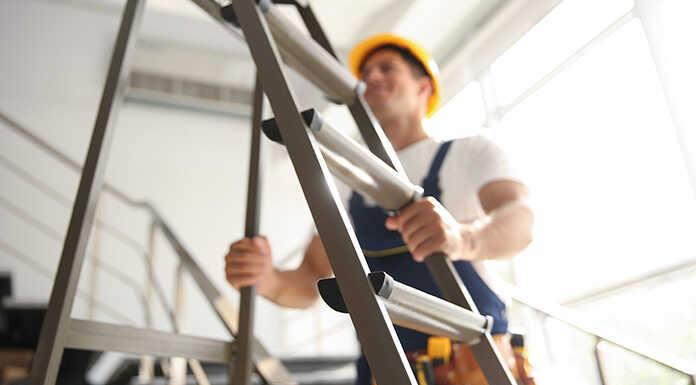What goes up must come down, right? Hopefully, in a safe manner, especially when working on a ladder. Did you know ladders ranked #3 in OSHA’s list of top 10 violations for 2023, and 50 percent of falls requiring medical attention are from 10 feet or less? For these reasons, you must take ladder safety seriously.
There are many types of ladders – extension, A-frame, platform, step, straight, telescoping, articulating, and orchard. These ladders have different purposes and may be made of different materials, such as wood, aluminum, or fiberglass. So, how can you be safe when working with ladders? Below are five steps to ladder safety everyone should take.
Step One – Choose the right ladder
- Conduct a job hazard analysis of the worksite.
- Is a ladder the best tool for the work?
- Could I use an alternative, such as a platform, scaffold, or lift instead?
- Will I be carrying materials? If so, consider the duty rating, which indicates the maximum weight capacity the ladder can safely carry. To figure out the total amount of weight your ladder can support, add the following:
- Your weight, plus
- The weight of your clothing and Personal Protective Equipment (PPE), plus
- The weight of tools and supplies you are carrying, plus
- The weight of tools and supplies stored on the ladder
- Make sure you select a ladder with the appropriate load capacity for the weight that will be on it. There are five categories of ladder duty rating based on weight:
- Type IAA (Extra Heavy Duty) – 375 lbs.
- Type IA (Extra Heavy Duty) – 300 lbs.
- Type I (Heavy Duty) – 250 lbs.
- Type II (Medium Duty) – 225 lbs.
- Type III (Light Duty) – 200 lbs.
Step Two – Consider the surrounding conditions
- Do not use ladders in high winds or storms.
- Will I be working on uneven surfaces?
- Will I be working by electricity or overhead powerlines? If working near power lines, do not use metal ladders as these conduct electricity. Instead, use a non-conductive ladder made of wood or fiberglass. Always assume all overhead lines are energized and dangerous.
Step 3 – Properly care for your ladder
- Conduct ladder inspections before initial use in each work shift and more frequently as necessary.
- Check the rungs, rails, labels, and locks. If anything is broken, cracked, or missing, the ladder must be taken out of service and marked, for example: “Dangerous – Do Not Use” and should be replaced.
- Any ladder that has been deemed unsafe must be destroyed in a manner that will render it useless. Another person must not be given an opportunity to use the ladder.
Step 4 – Follow best safety practices when using the ladder
- The ladder should not be placed in front of closed doors that can open toward the ladder. The door must be blocked open, locked, or guarded.
- Secure the ladder. Double-check stability and that it is extended three feet above the upper landing. Ladders may also need to be affixed to either a fascia/or gutter guard to improve stability.
- Place the ladder at the proper angle. When determining this, consider the 4:1 rule. For every four feet between the ground and the upper point where a ladder is resting, set the feet of the ladder out one foot horizontally. For example, if the ladder is resting on the edge of a roof 16 feet above the ground, the bottom of the ladder should be 4 feet out from the ledge.
- Verify if you need fall protection. Fall protection is required for fixed ladders above 24 feet.
- Always face the ladder when ascending and descending, and always use three points of contact. In other words, have two hands and one foot, or two feet and one hand in contact with the ladder steps, rungs, and/or side rails. This way, you are not likely to become unstable if one limb slips during the climb. It is important to note that you must not carry any objects in either hand that can interfere with a firm grip on the ladder. Tools belts can be helpful if you need to carry tools with you. You can also hoist tools using a pulley system or electric hoist. Wearing slip-resistant shoes is also recommended.
- Never attempt to move the ladder while standing on it or use the top ramp as a step. The ladder should extend three feet above the upper landing. Do not overreach or lean while working to prevent from falling off the ladder.
Step 5 – Influence ladder safety among your team
- Train employees on ladder selection, storage, how to properly carry ladders, and how to safely use the ladders.
- Conduct frequent ladder inspections and remove ladders that are no longer safe from usage. It is recommended to cut them in half to prevent employees from being tempted to try to use them even if they have been marked out of service.
- Observe employees and coach on correct usage.
If you follow these ladder safety tips, you will be on the right track to working safely so you can return home to friends and family each night. Don’t let ladder safety slip you by!
ICW Group’s Safety OnDemand learning management system, available for free with a workers’ compensation policy, contains a full suite of safety resources and a comprehensive learning management system to assist with ladder safety. In addition, ICW Group offers a Fall Protection Program Wizard, Fall Protection Program Audit, and a webinar to help with your Federal OSHA compliance efforts.
If you have any questions or need assistance developing your ladder safety program, please contact ICW Group’s Risk Management Services, and we will be more than happy to assist you.

















